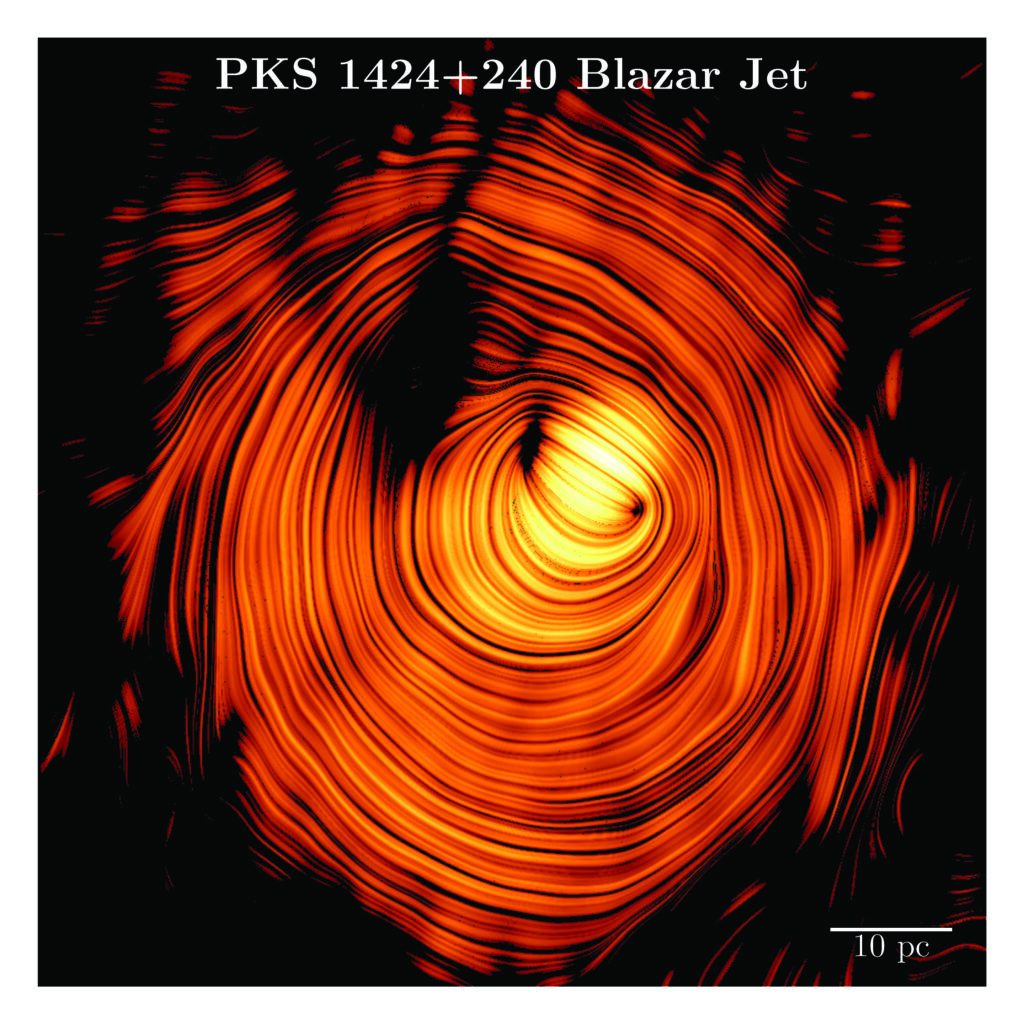
Astronomers have captured a breathtaking image of a cosmic jet, unveiling the “Eye of Sauron” in deep space. This discovery, centered on the blazar PKS 1424+240, has provided insights into the mysterious emission of high-energy gamma rays and neutrinos from this celestial phenomenon. The findings, published in the journal Astronomy & Astrophysics, may solve a long-standing cosmic puzzle.
The blazar, located billions of light-years away, has intrigued scientists for years. Despite being the brightest known neutrino-emitting blazar, its radio jet appeared to move sluggishly. This contradicted the expectation that only the fastest jets could produce such bright emissions. However, new data from the Very Long Baseline Array (VLBA) has revealed a stunning image of the jet, offering unprecedented resolution.
Unraveling the Mystery of PKS 1424+240
The blazar PKS 1424+240 has been a focal point for astronomers due to its exceptional brightness in high-energy gamma rays and cosmic neutrinos. Identified by the IceCube Neutrino Observatory, it also emits very high-energy gamma rays detected by ground-based Cherenkov telescopes. Yet, its slow-moving radio jet puzzled researchers.
Yuri Kovalev, the lead author of the study and Principal Investigator of the MuSES project at the Max Planck Institute for Radio Astronomy (MPIfR), remarked, “When we reconstructed the image, it looked absolutely stunning. We have never seen anything quite like it—a near-perfect toroidal magnetic field with a jet, pointing straight at us.”
“This alignment causes a boost in brightness by a factor of 30 or more,” explains Jack Livingston, a co-author at MPIfR. “At the same time, the jet appears to move slowly due to projection effects—a classic optical illusion.”
The Role of Magnetic Fields
The alignment of the jet almost directly toward Earth results in a dramatic amplification of its high-energy emission due to special relativity. This unique geometry allowed scientists to examine the blazar’s jet in detail, revealing its magnetic field structure. Polarized radio signals indicated a likely helical or toroidal shape, crucial for launching and collimating plasma flow and accelerating particles to extreme energies.
Kovalev concluded, “Solving this puzzle confirms that active galactic nuclei with supermassive black holes are not only powerful accelerators of electrons, but also of protons—the origin of the observed high-energy neutrinos.”
A Milestone in Multimessenger Astronomy
This discovery marks a significant achievement for the MOJAVE program, which has been monitoring relativistic jets in active galaxies for decades using the VLBA. The technique of Very Long Baseline Interferometry (VLBI) connects radio telescopes around the globe, forming a virtual telescope the size of Earth. This provides the highest resolution available in astronomy, allowing scientists to study the fine details of cosmic jets.
Anton Zensus, Director at MPIfR and co-founder of the MOJAVE program, reflected, “When we started MOJAVE, the idea of one day directly connecting distant black hole jets to cosmic neutrinos felt like science fiction. Today, our observations are making it real.”
This result strengthens the link between relativistic jets, high-energy neutrinos, and the role of magnetic fields in shaping cosmic accelerators—marking a milestone in multimessenger astronomy.
The study of PKS 1424+240 not only enhances our understanding of blazars but also contributes to the broader field of astrophysics, offering insights into the fundamental processes that govern the universe. As researchers continue to explore these cosmic phenomena, the potential for new discoveries remains vast.





